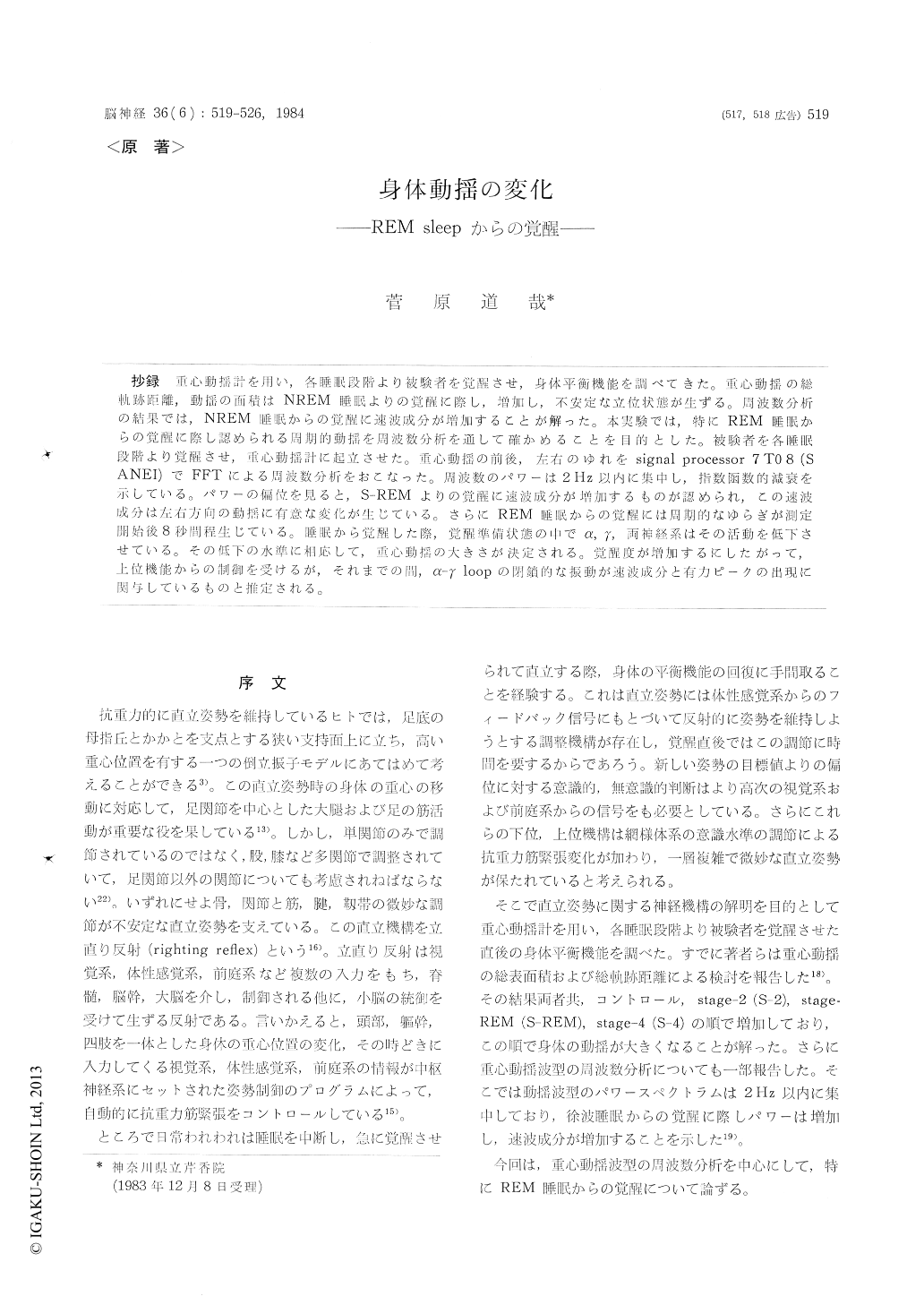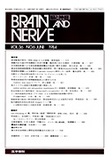Japanese
English
- 有料閲覧
- Abstract 文献概要
- 1ページ目 Look Inside
抄録 重心動揺計を用い,各睡眠段階より被験者庵覚醒させ身体平衡機能を調べてきた。重心動揺の総軌跡距離,動揺の面積はNREM睡眠よりの覚醒に際し,増加し,不安定な立位状態が生ずる。周波数分析の結果では,NREM 睡眠からの覚醒に速波成分が増加することが解った。本実験では,特にREM睡眠からの覚醒に際し認められる周期的動揺を周波数分析を通して確かめることを目的とした。被験者を各睡眠段階より覚醒させ,重心動揺計に起立させた。重心動揺の前後,左右のゆれをsignal processor 7 T0 8(SANEI)でFFTによる周波数分析をおこなった。周波数のパワーは2Hz以内に集中し,指数函数的滅衰を示している。パワーの偏位を見ると,S-REMよりの覚醒に速波成分が増加するものが認められ,この速波成分は左右方向の動揺に有意な変化が生じている。さらにREM睡眠からの覚醒には周期的なゆらぎが測定開始後8秒間程生じている。睡眠から覚醒した際,覚醒準備状態の中でα,γ,両神経系はその活動を低下させている。その低下の水準に相応して,重心動揺の大きさが決定される。覚醒度が増加するにしたがって,上位機能からの制御を受けるが,それまでの間,α—γloopの閉鎖的な振動が速波成分と有力ピークの出現に関与しているものと推定される。
The author previously examined functions of equilibrium of subjects using the statograph which records a movement of the center of gravity in a two dimentional trajectory. Results indicated that area enveloped by the trajectory and the total length of trajectory increased when subjects were awakened from NREM sleep. The analysis of frequency of the trajectory describing the body sway, which was performed using a signal proces-sor connected to the statograph, showed that the high frequency components of the trajectory also increased. The author had often observed that some subjects exhibited rythmic body sway im-mediately after awakened from stage-REM. The present report focuses the description of the rhyth-mic phenomena.
The subjects were nine healthy male volunteers with a mean age of 20 years. They were awakened by a buzzer at stages of rest, stage-4, stage-REM and stage-2, and were made to stand on the plat-form of the statograph for 60 seconds, with their eyes closing and their soles of feets opening at the angle of 30 degrees. Then, their body sway were recorded. Anterior-posterior and lateral components of their trajectories were simulta-neously examined by analyzing the trajectory by means of Fast Fourier Transformation method equiped in the signal processor.
The total length of the trajectory of body sway in nine cases awakened from respective stages were : rest (control), 690±133 ; stage-4, 1311±220; stage-REM, 911±188; and stage-2, 863±212mm (mean±SD). Power spectrum of the frequency of the trajectory was obtained with respect to the resolution of 0.0195Hz. The mean distribution of power spectra of nine subjects, who were awakened from all the stages, decreased exponent-ially and reached near zero within 2Hz. Six cases among the nine exhibited the increase of fast-wave components in both anterior-posterior and lateralcomponents when awakened from stage-REM. The fast-components in the lateral components were significantly large and the rhythmic oscil-lation of the body sway lasted for about eight seconds after the start of record.
Since the activity of alpha and gamma motor systems are generally known to be lowered in a preparation state toward complete awakening im-mediately after the forced waking, the increase of the fast-wave components observed in both antero-posterior and lateral components may beconsidered to be attributed to this lowed level of the system. Man is controlled by the higher mechanisms, the activity of which depends on the degree of awakening. It may concluded that the appearance of the rhythmic body sway with in-creasing fast-wave components in anterior-poste-rior and lateral components is caused by the motor activity probably oscillating on the alpha-gamma loop.

Copyright © 1984, Igaku-Shoin Ltd. All rights reserved.


